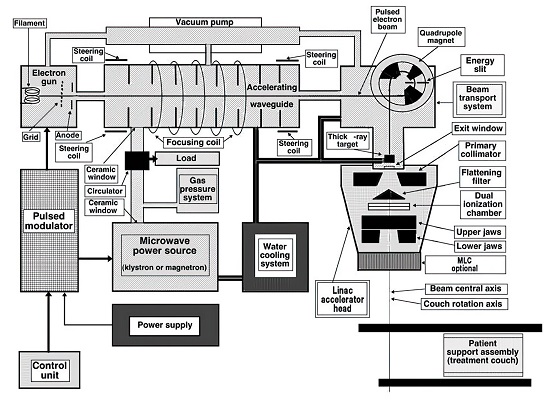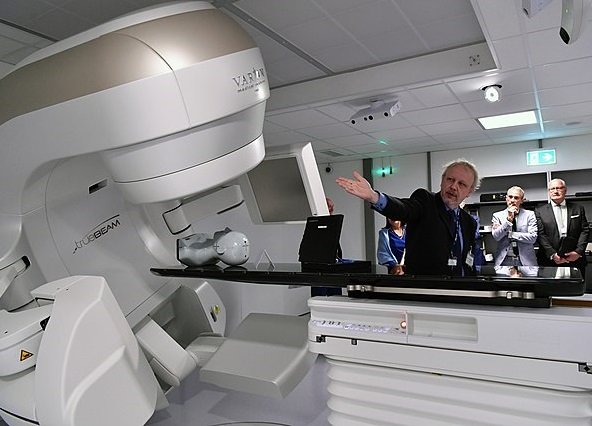Howdy, Dr. Zoomie! I was talking with a doctor the other day and he said something about using a linac to put some radiation on cancer to treat it. Thing is, I have no idea what a linac is or how it makes radiation – can you help me fill in the blanks here? I’m also wondering why, if radiation can give a person cancer, it’s also used to treat cancer. Thank you!
You know, that’s one of the problems with talking to anyone who’s an expert in their field is that they can forget that not everyone knows what they’re talking about. So let’s see if I can help out a little.
LINAC stands for LINear Accelerator – it’s a way to accelerate electrons to very high speeds. Sometimes the electrons themselves are used (they’ve used them to irradiate mail to try to kill anthrax as well as to irradiate meat and other foods to make them safe). Alternately, the electrons can be slammed into a metal plate where they produce x-rays and those x-rays can be focused on a tumor to kill the cancer cells. That’s the big picture – let’s look at some of the details, which are pretty interesting.
To start, electrons have an electrical charge and, like any charged particles, magnetic fields can make them change direction – this is how the Earth’s magnetic field traps cosmic rays in the van Allen radiation belts. In the case of a LINAC, a magnetic field is created by a series of magnets that run the length of a tube filled (sort of) with vacuum. As electrons are shot into the tube, the magnets are turned on and off in sequence, creating a sort of magnetic wave that moves down the tube, carrying the electrons with it – I think of the electrons as “surfing” on this magnetic “wave.”

Since the operators can control the speed of the wave, they can speed it up until the electrons are moving at incredibly high speeds – and they’re aimed at a metal target. When the electrons strike the targets, they create x-rays (think of striking sparks with a flint and a piece of metal); it’s these x-rays that are used to treat cancer.

One thing that bears mention is that these x-rays have a lot of energy – which is what makes them so effective at treating cancer (more on this in a moment). The reason for this is that the electrons are accelerated to very high speeds, and the amount of energy an electron carries is proportional to the square of its velocity. So doubling the speed increases the energy by a factor of 4 while increasing the velocity by a factor of 10 will increase its energy by a factor of 100. And since it’s the energy deposited in a tumor that’s important, these high velocities are (literally) vitally important.
So now we get to how radiation can both cause – and cure – cancer.
Here’s the thing – radiation damages DNA. It can damage the DNA directly by striking the DNA molecule and breaking it or causing it to change; it can also damage the DNA by causing chemical reactions within the cell and those chemical reactions can then go on to damage the DNA. Most of the time, that damage does not go on to cause cancer – sometimes it does. But that’s what happens when the DNA damage happens gradually, over a relatively long period of time, and it might take decades for the cancer to appear, part because our bodies can repair DNA damage as it occurs…but when you aim a beam of LINAC x-rays at a tumor, things are a bit different. What happens then is that the damage occurs much more quickly, overwhelming the cells’ ability to repair it as it occurs. This means that DNA damage builds up and, the higher the radiation dose, the more rapidly the damage accumulates. And if there’s enough damage – if enough genes are knocked out – the cell will die. When enough tumor cells die, the tumor will shrink, often to the point where it’s destroyed or where the body’s immune system can “kill” it.
One other thing ought to be mentioned – how to make sure the radiation only hits the tumor, sparing healthy tissue. This is done by using a “multi-leaf collimator” – a device with dozens of thin lead shields – to help shape the beam to match the outline of the tumor. As the radiation passes through the collimator the lead absorbs the x-rays striking the lead and the only radiation passing through is radiation that will hit the tumor. In this way the tumor can be destroyed while surrounding healthy tissues are not. Other techniques, including moving the beam to irradiate the tumor from different angles can be used to maximize radiation dose to the tumor while, again, reducing dose to the rest of the body.
I think this ought to answer your questions – and I hope it helps.
I also recommend this exceptionally good video on how LINACs work:
Sources:
- Header Image Reference: Enhancing the IAEA’s Dosimetry Laboratory: Opening of the Linear Accelerator Facility event at the Nuclear Applications (NA) Laboratories in Seibersdorf, Austria. 6 June 2019. Photo Credit: Dean Calma / IAEA
- LINAC Animation: Chetvorno @ WIkipedia Commons
- LINAC Diagram Image Source: E.B. Podgorask, Radiation Oncology Physics: A Handbook for Teachers and Students.
